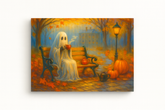15 Paint by Numbers Tips For Beginners
Paint by numbers is more than just a hobby, it's a powerful tool for relaxation, mindfulness, and creative expression. Whether you're just starting out or looking to make your artwork more realistic, this guide will teach beginners and seasoned veterans alike on how to make their paintings more polished, life-like & easy to complete.
Choose the Right Kit
Choosing the right kit is based both on your skill level and your interests.Beginners should opt for simpler designs with larger areas. As you progress you can choose more advanced kits with more detailed compositions. It’s also important to pick something you’d actually like to paint! Check out quality brands like PaintMeLike, known for vivid paints and clear linework. Avoid bargain kits from unknown sources or Amazon sellers with inconsistent reviews: they often come with faint outlines, poor paint colors, or low-quality brushes.
Prep Your Canvas with Gesso
Priming your canvas with clear gesso is an easy way to make your painting more lifelike. It gives the surface a slightly gritty texture, which helps the paint adhere better and go on smoother (making the whole picture appear less splotchy). Do not use white gesso as it can obscure the printed numbers and outlines. Apply a thin, even coat with a foam brush and allow it to dry completely before starting your project. This simple prep step can drastically improve your painting experience.
Stabilize and Elevate Your Canvas
Working on an uneven surface or on a table will lead to splotches and poor posture. By mounting your canvas on a foam board or sturdy birch panel you can keep it upright, which makes it easier to stay within the lines. If you’re willing to spend a few extra dollars use an easel to keep it upright and at eye level. Being able to rotate or reposition your canvas helps reduce wrist strain and ensures more accurate brushwork, especially in small detail areas.
Set Up a Clean, Comfortable Space
Make sure you set up a workspace that invites creativity, promotes peace and minimizes mess. Laying down a bit of newspaper or a drop cloth to protect your surfaces will ensure you don’t stain any furniture or clothing. Lighting is also extremely important when working on a paint by numbers kit. LED lamps or even a headlamp can help illuminate fine lines and reduce the strain on your eyes. If your eyesight needs a boost, magnifying glasses or wearable magnifiers with lights can make a big difference.
Use High Quality Brushes
The brushes included in most kits are serviceable, but upgrading makes a noticeable difference to the overall quality of your painting. Add a few detail and angled brushes to your toolkit for better control. Soften new brushes in water before use to open the bristles. For ultra-tiny sections, try repurposing cheap eyeliner brushes: they're precise, disposable, and surprisingly effective. Always rinse brushes thoroughly between colors to maintain clean lines and avoid contaminating paints.
Master Paint Consistency with Flow Improver
Acrylic paint can dry out fast or become too thick, affecting smoothness. Mix a small amount of flow improver with your rinse water (20:1 water to flow improver ratio). Dip your brush, blot it dry, and you'll notice a silkier application. For a budget option, combine bottled water with a few drops of vegetable glycerin. The goal is consistent, flowing paint that glides rather than clumps.
Start With Light or Dark: Your Choice
There's no strict rule about whether to go light to dark or dark to light. Dark paints cover lines more easily, but lighter colors make it easier to adjust shading. Try both methods on different sections and stick with the one that feels best to you. Many painters start from the top left (if right-handed) to minimize smudging as they work.
Use One Color Across the Canvas
To minimize the amount of times you need to clean brushes, focus on completing all areas of one color before switching. Also make sure to take clear, close-up photos of the entire canvas before you start: they're invaluable for locating missed spots or fixing mistakes later.
Cover Numbers Before Painting
If you are using light paint, sometimes numbers can show through the paint. Use a white gel pen, paint marker, or even thick white wall paint to cover numbers before applying your color. This ensures solid, clean coverage and a more professional appearance, especially in large light areas.
Use Small Amounts of Paint
Less is more when it comes to paint quantity. Use thin, even coats to maintain detail and avoid texture buildup. If a single coat doesn't fully cover the lines, wait for it to dry and apply another. Multiple light coats look cleaner and blend better than one heavy layer.
Practice Blending for Realism
Want your piece to look like a true painting rather than a color-by-number? Practice blending colors where zones meet. Use a slightly damp brush to feather the edge of one color into the next. Test your technique on scrap paper before trying it on your canvas. This step can transform your project into a gallery-worthy work.
Fix Mistakes Properly
Everyone makes mistakes, and colors outside the lines on occasion but how you fix them matters. Let the area dry completely before you try to fix it. Then apply a light layer of white paint to cover the error, and repaint with the correct color. Never wipe wet paint: you'll risk smudging and damaging the canvas. Patience is key.
Take Reference Photos
Numbers can disappear under paint or become unreadable. Take high-resolution photos of the canvas (ideally in sections) before starting. These images serve as a backup guide, especially if the included paper map is unclear or missing.
Keep Paints Fresh
Acrylics dry quickly when exposed to air. Always close lids tightly after use and consider transferring paints into travel-size containers with tighter seals. Only mix in flow improver or water with the portion you're actively using to avoid thinning the entire pot. Minimizing exposure helps paints stay smooth and usable.
Seal and Frame Your Artwork
Seal your completed painting with a clear acrylic spray or Mod Podge to protect the surface and preserve the brightness of your colors. If you are interested in displaying your artwork you can frame it to really make it look professional. Painting the back of the canvas white can also prevent backlight from revealing hidden numbers or brush marks.






